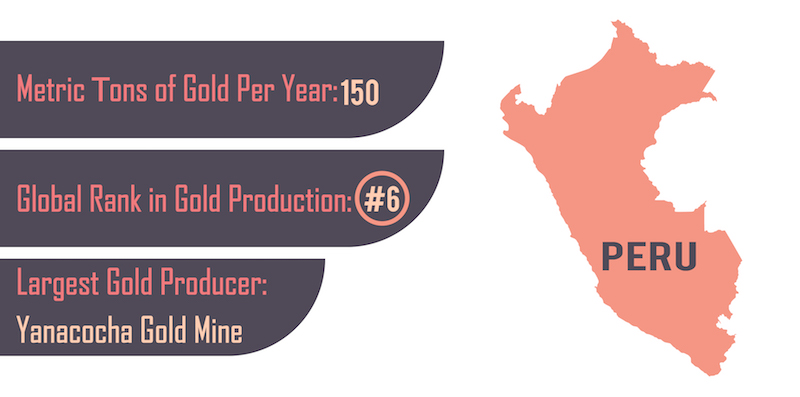
Peru is the biggest producer of gold in all of Latin America, and is ranked in the sixth position at world level. However, despite Peru being endowed with gold, it struggles with the challenge of illegal gold mining this has really affected the industry in a negative way by introducing pollution and affecting the population in a negative way.
Despite the challenges, it is unfair to categorize the gold as a curse the way so much of the reporting on mining in this country. Indeed, it is important to mine in a responsible way, but on a continent where so many people are struggling with poverty one should consider the benefits of living in the most gold-rich country in South America.
Extensive Jungle Gold Deposits
Some reports have revealed that Peru is believed to have the largest potential for unexploited gold deposits that have yet be fully explored.
The Peruvian government does not have strict measures put in place to restrict the mining processes of gold. As a result, this has encouraged both the foreign based investors to express interest in the sector of gold mining, as well as the local investors of whom the majority conduct mining illegally.
Peru’s gold mining industry is also known to have been on the increase recently, due to the favourable price increase of gold on the market. However, the mining operations of gold extraction have continued to pose challenges on the environment, health and the general security of the place.

Major Mines Operating in Peru
In spite of all the challenges posed by gold mining industry, Peru has continued to attract large-scale mining companies on board. For example, the Yonacoda Gold mine located in the Northern part of Peru is managed by Newmont Mining Corporation.
The Yonacoda Gold mine is believed to be the second largest open-pit mine for gold in the whole world. Reports show that the mine has now produced gold that is worth over $7 billion dollars.
Gold in Peru is believed to be highly concentrated in areas of the Andes Mountains. However, placer gold deposits in Peru also occur in the many rivers that flow across the jungles. This is where much of the illegal mining is taking place by artisanal miners.
Other gold bearing locations in Peru include areas in the southern region, where the Chucapaca Mine is found. This mine is one of the largest gold producers. It is also estimated that the mine has 4.3 million ounces of gold in its reserves.
Apart from the Chucapaca Mine, the south-eastern part of Peru hosts a large open-pit gold mine called the Rio Huaypetue Mine, which is situated in Cusco Region in the vicinity of the border of Madre de Dios and Puno regions. This mine is one of those found in the remote areas of the Peruvian Amazon.
The north-western part of Peru is also on the record of being home to one of the largest gold mines; this mine is called the Legunas Norte Mine. The mine is also located in La Libertad region and has estimated gold reserves of 5.8 million ounces of gold.
Other places that have not been left out in gold production in Peru include the Province of Oyon, which is home to the Uchucchacua Mine. This is one area that has good potential for new discoveries in the future.
Artisanal Miners in the Peruvian Jungles
The widespread availability of gold in various locations of Peru has led to the increase in the gold mining activities among the small-scale miners. Most of these miners have few material goods, and limited economic means. Gold offers them a chance to make some money in a place where earning a living can be hard.
This mining activity has brought about a number of challenges. Despite being warned on the dangers of some methods used in gold mining, such as the use of mercury, the miners seem to have turned a deaf hear to the advice. As a result, residents of nearby villages are highly exposed to the health risks that come with illegal gold mining.
This is a challenge faced throughout much of the world. The prevalent use of mercury to extract fine gold from sands and gravel causes all sorts of problems.
Mercury amalgamation is a process that has been known for centuries and it works extremely well. Much of the gold being recovered is in fine placers among silts in the river, and there are few options to extract it without using mercury.
There is certainly technology out there that makes the need for mercury obsolete. In the United States, very few miners use mercury anymore because we have access to fine gold processing equipment like shaker tables and gold concentrating equipment.
Peru is very different. These people do not have access to the latest mining technology and are limited to using primitive methods to extract and recover this fine gold. As a result, we can expect more challenges associated with pollution until people have greater access to higher quality placer mining equipment.
In a nutshell, gold mining in Peru is one of the thriving industries through which a number of people are making ends meet. The prevalence of mining – on both a small and large-scale – is a clear indication that the country is endowed with great potential.
Next: Found in Mexico – 389 Ounce Solid Gold Nugget!
